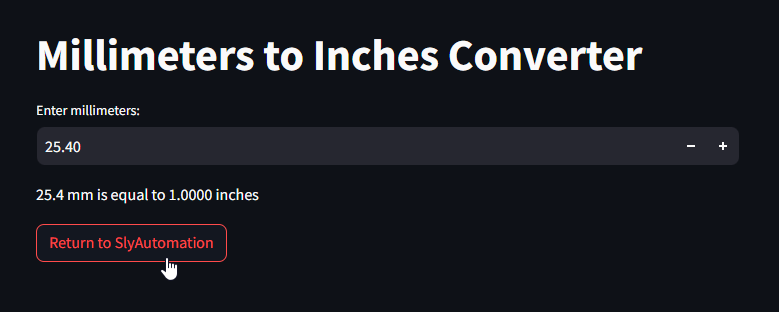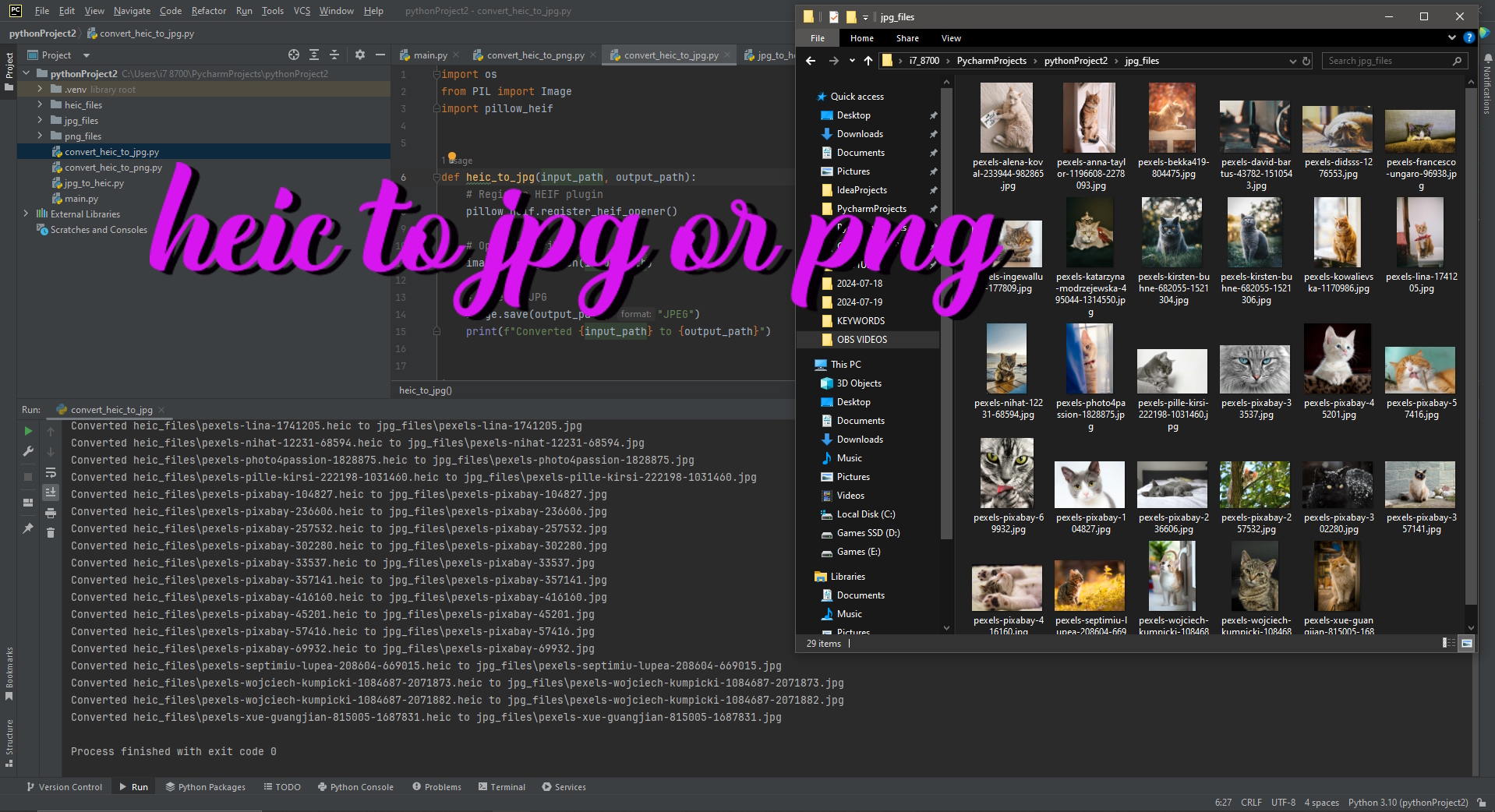Millimeters to Inches Converter
When it comes to unit conversions, Python can convert mm to inches with ease and in a user friendly way, offering a powerful toolset to simplify the process. In this tutorial, we’ll delve into creating a user-friendly GUI application that converts mm to inches using the Tkinter library. By the end, you’ll have a fully functional tool at your disposal.
The Python Script: coding mm to inches
In the realm of GUI development, Tkinter stands out as a versatile library. We’ll leverage its capabilities to create an intuitive interface for our millimeters to inches converter. Here’s a breakdown of the key components for mm to inches:
1. Importing the Necessary Libraries
import tkinter as tkWe kick off by importing the tkinter library, which provides the building blocks for our graphical user interface that will incorporate the mm to inches.
2. Defining the Conversion Logic for mm to inches app
def convert():
try:
mm_value = float(entry_mm.get())
inches_value = mm_value / 25.4
label_result.config(text=f'{mm_value} mm is equal to {inches_value:.4f} inches')
except ValueError:
label_result.config(text='Invalid input. Please enter a numeric value.')The convert function encapsulates our conversion logic. It extracts the millimeter value from the user input, performs the conversion, and updates the result label. Robust error handling ensures a smooth user experience and prevent errors when calculating mm to inches.
Let’s break down each line of the code:
try:
- The
tryblock is used to enclose a section of code that might raise an exception (an error). In this case, it’s used to catch aValueErrorif the user enters a non-numeric value.
mm_value = float(entry_mm.get())
entry_mm.get()retrieves the text entered by the user in the Tkinter Entry widget (entry_mm).float()converts this text to a floating-point number. This line stores the millimeter value entered by the user in the variablemm_value.
inches_value = mm_value / 25.4
- This line calculates the equivalent inches value by dividing the millimeter value (
mm_value) by the conversion factor 25.4. The result is stored in the variableinches_value.
label_result.config(text=f'{mm_value} mm is equal to {inches_value:.4f} inches')
- This line updates the text of the
label_resultlabel widget with the result of the conversion. It uses an f-string to format the text dynamically, incorporating the original millimeter value (mm_value) and the calculated inches value (inches_value). The:.4fspecifies that the inches value should be displayed with four decimal places.
except ValueError:
- The
exceptblock catches a specific exception, in this case,ValueError. If the conversion to a float in line 2 fails (e.g., because the user entered a non-numeric value), the code within theexceptblock will be executed.
label_result.config(text='Invalid input. Please enter a numeric value.')
- Inside the
exceptblock, this line updates the text of thelabel_resultlabel widget to indicate that the user provided an invalid input. Specifically, it prompts the user to enter a numeric value.
In summary, these lines of code handle the conversion of millimeters to inches and update the GUI with the result or an error message, ensuring a smooth user experience and robust error handling.
3. Creating the GUI Components
window = tk.Tk()
window.title('MM to Inches Converter')
label_mm = tk.Label(window, text='Enter millimeters:')
entry_mm = tk.Entry(window)
convert_button = tk.Button(window, text='Convert', command=convert)
label_result = tk.Label(window, text='')Here, we set up the main window, labels, entry field, button, and a result label. These elements form the foundation of our user-friendly interface for mm to inches.
4. Running the Application
window.mainloop()Finally, the mainloop function keeps our GUI application running, allowing users to interact with it seamlessly.
Here’s what the mm to inches tkinter app looks like:

The Conversion Process: Simplified and Accurate
The conversion itself is straightforward. Upon entering a millimeter value and clicking the “Convert” button, our Python script performs the necessary calculations. The result is displayed with precision, making it an effective tool for various applications that use mm to inches.
Why Choose Python for Unit Conversions?
- Ease of Use: Python’s syntax is clear and concise, making it accessible for both beginners and experienced developers.
- Versatility: Python’s extensive libraries, like Tkinter, empower developers to create feature-rich applications without unnecessary complexity.
- Community Support: Python boasts a robust community that provides ample resources and assistance, making problem-solving a collaborative effort.
mm to inches Python Web App using Streamlit!

To create a Python Streamlit app for the millimeters to inches converter, you can use the following code. Make sure you have Streamlit installed before running the script:
pip install streamlitHere’s the Streamlit app code:
import streamlit as st
def mm_to_inches_converter(mm_value):
try:
inches_value = mm_value / 25.4
return inches_value
except ValueError:
return "Invalid input. Please enter a numeric value."
def main():
st.title("Millimeters to Inches Converter")
# Get user input for millimeter value
mm_value = st.number_input("Enter millimeters:", min_value=0.0, step=1.0)
# Convert millimeters to inches
inches_result = mm_to_inches_converter(mm_value)
# Display result
st.write(f"{mm_value} mm is equal to {inches_result:.4f} inches")
if __name__ == "__main__":
main()To run the Streamlit app, save the code in a file (e.g., streamlit_mm_to_inches_converter.py) and execute the following command in your terminal:
streamlit run streamlit_mm_to_inches_converter.pyThis will start a local server, and you can view the app in your web browser by visiting the provided URL.
Explanation of key parts:
st.title("Millimeters to Inches Converter"): Sets the title of the Streamlit app.st.number_input("Enter millimeters:", min_value=0.0, step=1.0): Creates an input widget for the user to enter millimeter values.mm_to_inches_converter(mm_value): Function to perform the conversion from millimeters to inches.st.write(f"{mm_value} mm is equal to {inches_result:.4f} inches"): Displays the result of the conversion.
Streamlit automatically handles the user interface, and this app provides a simple and interactive way to convert millimeters to inches.



Conclusion: Unlocking Efficiency with Python
In this tutorial, we’ve explored the creation of a millimeters to inches converter using Python’s Tkinter library and another using the streamlit webapp solution. The script’s simplicity and efficiency make it a valuable tool for anyone needing quick and accurate unit conversions.
Whether you’re a Python novice or a seasoned developer, this tutorial provides a solid foundation for understanding GUI development and unit conversion in Python. Harness the power of Python to create customized solutions for your projects.
By combining practical coding examples with clear explanations, this tutorial equips you with the knowledge to seamlessly implement a millimeters to inches converter in Python. Start coding and elevate your understanding of GUI and Web applications and unit conversions today.
Need more python app ideas? Check out: Youtube to mp3 code or dice roller app
















Major thanks for the article post.Thanks Again. Will read on…
I loved your article post.Really thank you! Really Cool.
Thanks-a-mundo for the blog post.Thanks Again. Fantastic.
I cannot thank you enough for the blog article.Much thanks again. Really Cool.
Awesome article.Really thank you! Fantastic.
I really like and appreciate your blog.Thanks Again. Much obliged.
Appreciate you sharing, great post.Much thanks again. Keep writing.
Thanks-a-mundo for the article post.Really thank you! Keep writing.
I really enjoy the blog.Thanks Again.
Thanks-a-mundo for the article post.Really looking forward to read more. Much obliged.
Very informative article.Thanks Again. Really Cool.
Major thankies for the blog post.Thanks Again. Much obliged.
Great, thanks for sharing this blog article.Much thanks again. Much obliged.
This is one awesome blog.Much thanks again. Fantastic.
Im thankful for the blog post.Really looking forward to read more. Awesome.
I appreciate you sharing this blog article.
onlinepharmacy order cipro online supreme suppliers onlinepharmacy
An intriguing discussion is definitely worth comment. I believe that you ought to write more about this subject, it might not be a taboo subject but usually people do not discuss these issues. To the next! Cheers!!
ivermectin tablets ivermectine tabletten uk Opgcecow stromectol generic
Hey, you used to write fantastic, but the last few posts have been kinda boring… I miss your great writings. Past few posts are just a little bit out of track! come on!
I will right away grab your rss feed as I can’t find your emailsubscription link or newsletter service. Do you’ve any? Kindly allow meknow so that I may just subscribe. Thanks.
Im thankful for the article.
Thanks for the blog article.Really looking forward to read more. Really Great.
I truly appreciate this article.Really thank you! Will read on…
Very good article post.Really looking forward to read more. Really Great.
Really informative article post.Much thanks again. Keep writing.
Very neat article post.Really thank you! Want more.
I am so grateful for your article post.Really thank you! Much obliged.
Appreciate you sharing, great article.Thanks Again. Much obliged.
I loved your article.Much thanks again. Keep writing.
Very informative blog. Great.
Thank you for your blog. Awesome.
Thanks for the post.Much thanks again. Really Great.
Major thankies for the blog post.Much thanks again. Want more.
this is be cool 8) fruit frenzy Dow Jones: The Dow Jones branded indices are proprietary to and are calculated, distributed and marketed by DJI Opco, a subsidiary of S&P Dow Jones Indices LLC and have been licensed for use to S&P Opco, LLC and CNN
Appreciate you sharing, great blog post. Really Great.
This is one awesome blog.Much thanks again. Want more.
I appreciate you sharing this blog post.Really looking forward to read more. Keep writing.
Wow, great article.Much thanks again. Really Cool.
A big thank you for your blog article. Great.
Very good blog. Will read on…
I cannot thank you enough for the blog.Really looking forward to read more. Awesome.
I love what you guys are usually up too. This sort of clever work and reporting! Keep up the terrific works guys I’ve added you guys to blogroll.
Asking questions are genuinely nice thing if you are not understanding something totally, however this piece of writing gives fastidious understanding yet.
I really like and appreciate your article post.Thanks Again. Much obliged.
A motivating discussion is definitely worth comment. I believe that you ought to write more about this issue, it might not be a taboo matter but usually people do not speak about these subjects. To the next! Cheers!!
I am so grateful for your blog post.Really looking forward to read more. Will read on…
An intriguing discussion is worth comment. There’s no doubt that that you should write more about this topic, it may not be a taboo subject but generally people do not talk about such topics. To the next! Kind regards!!
Thanks a lot for the blog.Thanks Again. Great.
Normally I don’t read post on blogs, but I would like to say that this write-up very pressured me to check out and do so! Your writing taste has been surprised me. Thank you, quite nice article.
Great, thanks for sharing this blog post. Fantastic.
hydroxychloroquine 400 hydroxychloroquine – plaquenil osteoarthritis
# Harvard University: A Legacy of Excellence and Innovation
## A Brief History of Harvard University
Founded in 1636, **Harvard University** is the oldest and
one of the most prestigious higher education institutions in the United
States. Located in Cambridge, Massachusetts, Harvard has built a global reputation for academic
excellence, groundbreaking research, and influential
alumni. From its humble beginnings as a small college established to educate clergy, it has evolved into a world-leading university that shapes the future across
various disciplines.
## Harvard’s Impact on Education and Research
Harvard is synonymous with **innovation and intellectual leadership**.
The university boasts:
– **12 degree-granting schools**, including the
renowned **Harvard Business School**, **Harvard Law School**, and **Harvard Medical School**.
– **A faculty of world-class scholars**, many of whom are Nobel laureates, Pulitzer Prize winners, and pioneers in their fields.
– **Cutting-edge research**, with Harvard leading initiatives in artificial intelligence,
public health, climate change, and more.
Harvard’s contribution to research is immense,
with billions of dollars allocated to scientific discoveries and technological advancements
each year.
## Notable Alumni: The Leaders of Today and Tomorrow
Harvard has produced some of the **most influential figures** in history, spanning politics, business, entertainment,
and science. Among them are:
– **Barack Obama & John F. Kennedy** – Former
U.S. Presidents
– **Mark Zuckerberg & Bill Gates** – Tech visionaries (though
Gates did not graduate)
– **Natalie Portman & Matt Damon** – Hollywood icons
– **Malala Yousafzai** – Nobel Prize-winning activist
The university continues to cultivate future leaders who shape industries and drive global
progress.
## Harvard’s Stunning Campus and Iconic Library
Harvard’s campus is a blend of **historical charm and modern innovation**.
With over **200 buildings**, it features:
– The **Harvard Yard**, home to the iconic **John Harvard Statue** (and the famous “three lies” legend).
– The **Widener Library**, one of the largest university libraries
in the world, housing **over 20 million volumes**.
– State-of-the-art research centers, museums, and performing arts venues.
## Harvard Traditions and Student Life
Harvard offers a **rich student experience**, blending academics with vibrant traditions,
including:
– **Housing system:** Students live in one of 12 residential houses, fostering a
strong sense of community.
– **Annual Primal Scream:** A unique tradition where students de-stress by
running through Harvard Yard before finals!
– **The Harvard-Yale Game:** A historic football
rivalry that unites alumni and students.
With over **450 student organizations**, Harvard students engage in a diverse range of extracurricular activities, from entrepreneurship
to performing arts.
## Harvard’s Global Influence
Beyond academics, Harvard drives change in **global policy, economics, and technology**.
The university’s research impacts healthcare, sustainability, and artificial intelligence, with partnerships across
industries worldwide. **Harvard’s endowment**, the largest of any university, allows it to fund scholarships,
research, and public initiatives, ensuring a legacy of impact for generations.
## Conclusion
Harvard University is more than just a school—it’s a
**symbol of excellence, innovation, and leadership**.
Its **centuries-old traditions, groundbreaking discoveries,
and transformative education** make it one of the most influential institutions in the world.
Whether through its distinguished alumni, pioneering research,
or vibrant student life, Harvard continues to shape the future in profound ways.
Would you like to join the ranks of Harvard’s legendary scholars?
The journey starts with a dream—and an application!
https://www.harvard.edu/
Great, thanks for sharing this blog post.Really thank you! Great.
I loved your blog.Thanks Again. Fantastic.
Really enjoyed this article post.Much thanks again. Much obliged.
A round of applause for your post.Really thank you!
Major thankies for the blog article. Want more.
I appreciate you sharing this blog article.Much thanks again. Awesome.
Thanks so much for the article post. Want more.
Верификация прошла быстро, никаких лишних вопросов.
Pinco Casino
Looking forward to reading more. Great article post. Want more.
slots for real money online gambling online slot games
Major thanks for the article.Really thank you! Will read on…
best research tadalafil 2017 zhengzhou debao tadalafil
Казино работает стабильно, никаких глюков и зависаний.
комета казино зеркало
Major thankies for the article post.Much thanks again. Keep writing.
I am constantly searching online for tips that can facilitate me. Thanks!
Excellent post. I was checking continuously this blog and I am impressed! Extremely useful info specifically the last part 🙂 I care for such info much. I was seeking this particular info for a very long time. Thank you and best of luck.
ivermectin for heartworms stromectol online pharmacy
Im obliged for the article post.Thanks Again. Really Great.
Ja naprawdę skarb twoją dzieło, Świetny post test koronawirus.
Really informative post.Really thank you! Great.
Hmm is anyone else experiencing problems with the pictureson this blog loading? I’m trying to find out ifits a problem on my end or if it’s the blog.Any suggestions would be greatly appreciated.
I am so grateful for your article.Really looking forward to read more.
I take pleasure in, result in I discovered just what I was looking for. You have ended my 4 day long hunt! God Bless you man. Have a nice day. Bye
I’m no longer certain the place you are getting your information, but good topic. I must spend some time learning much more or working out more. Thanks for excellent info I was searching for this info for my mission.
I really liked your article.Much thanks again. Want more.
I loved your post.Really looking forward to read more. Will read on…
Muchos Gracias for your blog post.Thanks Again. Will read on…
Say, you got a nice blog. Really Great.
Thanks for the auspicious writeup. It actually was a enjoyment account it. Look complex to more delivered agreeable from you! However, how could we communicate?
I enjoy, result in I discovered just what I was having a look for. You have ended my four day long hunt! God Bless you man. Have a nice day. Bye
Inspiring story there. What occurred after? Good luck!
What a truly magnificent post this is. Genuinely, outstanding amongst other presents I’ve ever seen on find in as long as I can remember. Amazing 바카라사이트
UK casino best non gamstop casino reviews Gamstop platforms are
unbeatable for fun!
pain reducer pills eds – all treatments for erectile dysfunction can you take pills for ed along with propecia
Many thanks, Plenty of info.college essay plagiarism affordable writing services custom thesis writing services
In fact when someone doesn’t know then its up to other people that they will assist, so here it happens.
Well I truly liked studying it. This subject provided by you is very practical for correct planning.
Букмекерские с букмекеры которые дают фрибетом — где самые простые
правила?
Кейсы CS2 с топовыми ножами — мечтаю выбить!
https://systemcheck-wiki.de/index.php?title=Benutzer:GinoHoward7783
Im obliged for the blog post.Really looking forward to read more. Keep writing.
Very neat blog.Much thanks again. Great.
Very informative post. Fantastic.
wow, awesome post.Thanks Again. Want more.
zithromax liquid – zithromax antibiotic zithropls zithromax online
Gunnpod Evo’s
new features make it stand out—love the adjustable airflow.
Ja naprawdę wartość twoją dzieło, Świetny post szybki test na covid 19.
Спасибо за чуткость и понимание
ритуальна служба Грааль
Легальные букмекеры России: Рейтинг и выбор
конторы
Обзор легальных букмекерских контор в России
Ключевыми игроками считаются “Фонбет”,
“Winline”, “BetBoom” и “Liga Stavok”, но важно учитывать, что условия каждой компании постоянно меняются.
Бонусные предложения, глубина росписи и доступные
спортивные дисциплины существенно различаются.
Перед регистрацией настоятельно рекомендуется изучить пользовательское соглашение на предмет скрытых комиссий и ограничений.
Так, некоторые площадки могут ограничивать максимальную
сумму ставки для определенных аккаунтов или видов спорта.
В данном материале представлен структурированный анализ текущего состояния
рынка интерактивных пари в России.
Акцент сделан на объективных критериях оценки и практических советах, которые помогут
игрокам сделать осознанный выбор и избежать потенциальных
проблем. Мы рассмотрим, как
анализировать коэффициенты, проверять репутацию площадки и использовать альтернативные
источники информации для формирования
собственного мнения.
Топ букмекерских организаций в России
Национальный рынок азартных игр представлен несколькими крупными игроками, которые предлагают
разнообразие услуг. Проанализировав доступные конторами
предложения, можно выделить несколько самых популярных вариантов, которые заслуживают
внимания.
Фонбет – одна из старейших структур
на рынке, предоставляет широкий выбор спортивных событий.
Широкая линия ставок и удобный интерфейс
приложения впечатляют, а бонусы для новых пользователей делают их предложение привлекательным.
1xBet – платформа известна своим многообразием игр и событий.
В ней интегрированы живые трансляции,
что позволяет следить за происходящим в
режиме реального времени. Бонусная политика радует новыми пользователями
и постоянными игроками.
Париматч – отличается разнообразием
доступных видов спорта и событий, а также развитой
экосистемой для пользователей.
Например, наличие кассовых услуг делает работу с ресурсом более
комфортной.
Леон – предоставляет интересные
маркетинговые предложения и часто обновляет бонусы.
Удобный сайт и мобильное приложение демонстрируют доступность
и простоту в использовании.
В выборе оптимального варианта
важно учитывать не только коэффициенты и линии ставок, но и уровень сервиса,
скорость выплат и доступные методы пополнения счета.
Прежде всего, стоит протестировать приложение и ознакомиться с отзывами
пользователей. Так можно найти решение, соответствующее
вашим ожиданиям и потребностям.
Как выбрать надёжную букмекерскую
организацию?
При выборе надёжной букмекерской компании, следует обращать внимание на несколько
важных факторов. Во-первых, стоит удостовериться,
что компания имеет лицензию и осуществляет деятельность на легальных основаниях.
Это гарантирует, что игрок будет защищён законом и сможет рассчитывать на выплату выигрышей.
Кроме того, необходимо изучить репутацию организации.
Отзывы пользователей, рейтинг букмекерови и оценки экспертов помогут составить представление о надёжности
компании, качестве предоставляемых услуг и скорости обработки запросов.
Следует отдавать предпочтение компаниям с положительной
репутацией и длительным стажем работы.
Также важно обратить внимание на линию событий, коэффициенты и роспись.
Надёжные организации, как правило, предлагают широкий выбор спортивных событий, выгодные коэффициенты и детальную роспись рынков.
Это позволяет игрокам делать
более осознанные ставки и увеличивает
шансы на успех.
Таким образом, при выборе надёжной букмекерской организации следует учитывать наличие
лицензии, репутацию компании, линию событий,
коэффициенты, роспись и качество платёжных сервисов.
Тщательный анализ этих критериев позволит найти компанию, которая обеспечит безопасный и комфортный игровой
опыт.
Миграционный юрист в Казахстане: Ваш Навигатор по ВНЖ, РВП и Легализации
Казахстан все больше привлекает людей со всего
мира – для работы, бизнеса, учебы или воссоединения с
семьей. Однако переезд и жизнь в
новой стране всегда связаны
с необходимостью ориентироваться в местном законодательстве, особенно в такой сложной и динамично меняющейся сфере, как миграционное право.
Запутанные процедуры, строгие
требования и языковой барьер могут стать серьезным препятствием на пути к
легальному и комфортному пребыванию в Республике Казахстан.
Именно здесь на помощь приходит квалифицированный миграционный
юрист Казахстан.
Легализация и РВП: Первые шаги в РК
Первое, с чем сталкивается любой иностранный гражданин – это необходимость законного оформления своего
пребывания. Легализация РК начинается с постановки
на миграционный учет, но для более длительного нахождения часто требуется получение Разрешения на временное проживание.
РВП Казахстан – это документ, позволяющий находиться в стране от нескольких месяцев до года (в
зависимости от оснований: работа, учеба, лечение,
воссоединение семьи и др.).
Процедура его получения требует внимательности
и знания актуальных правил, ведь даже небольшая ошибка может привести
к отказу. Юрист поможет определить подходящее основание, подготовить пакет
документов и пройти процедуру максимально гладко.
Вид на жительство (ВНЖ): Стабильность
и Новые Возможности
Следующий важный этап для тех,
кто планирует связать свою жизнь с Казахстаном
надолго, – получение ВНЖ Казахстан.
Вид на жительство РК предоставляет иностранцу практически те же права, что и гражданам страны (за
исключением избирательных прав и некоторых других), открывая путь
к стабильности, социальным
гарантиям и возможности в будущем претендовать на гражданство.
Процесс получения ВНЖ более сложен, чем РВП:
необходимо подтвердить
свою платежеспособность, отсутствие опасных заболеваний и судимостей, а
также правильно оформить множество документов.
Опытный юрист станет вашим надежным
проводником на этом пути, минимизируя риски отказа.
Защита прав и решение сложных вопросов
Деятельность миграционного юриста не ограничивается
лишь помощью в оформлении документов.
К сожалению, иностранные граждане могут столкнуться с различными проблемами:
необоснованные отказы в выдаче РВП или ВНЖ,
трудности при взаимодействии с миграционной службой РК, угроза выдворения или депортации, нарушение трудовых прав.
В таких ситуациях необходима профессиональная защита прав
иностранцев. Юрист поможет обжаловать
незаконные решения, представит ваши интересы в
государственных органах и суде, найдет правовое решение даже в самых сложных ситуациях,
руководствуясь нормами миграционного права РК.
Почему стоит обратиться к специалисту?
Самостоятельное изучение законов и попытки оформления документов могут отнять много времени, сил и привести к досадным ошибкам с серьезными последствиями.
Обращение к миграционному юристу – это инвестиция в ваше
спокойствие и уверенность в завтрашнем дне.
Специалист обладает глубокими знаниями законодательства и правоприменительной практики, опытом взаимодействия с госорганами и может предложить оптимальную стратегию для вашей конкретной ситуации.
Это реальная помощь мигрантам на всех этапах – от первичной консультации до получения
желаемого статуса и защиты ваших законных интересов.
Не рискуйте своим будущим в Казахстане.
Если вам нужна помощь в легализации, оформлении РВП, ВНЖ или требуется защита
ваших прав, обратитесь за
профессиональной юридической консультацией
https://wiki.roboco.co/index.php/Femida_70H
Фрибет за депозит в гандболе как его
использовать
Фрибет за депозит – как использовать на гандбол
Гандбол – захватывающий вид спорта, который привлекает внимание миллионов
поклонников по всему миру.
Одним из ключевых аспектов,
способствующих росту популярности
этой игры, являются различные акционные
предложения, предоставляемые букмекерскими конторами.
Эти специальные поощрения представляют собой отличную возможность для игроков увеличить свои шансы на выигрыш и получить
дополнительную прибыль.
Акции и призы для гандбольных болельщиков – это не просто маркетинговый ход, а реальная возможность для азартных любителей спорта преумножить свои денежные средства.
Грамотное использование таких предложений может стать ключом
к успеху в ставках на гандбол.
Один из наиболее востребованных бонусов для гандбольных фанатов – это так называемые «приветственные пакеты».
Они представляют собой комплекс поощрений, полученных при регистрации нового
игрока в букмекерской конторе.
Эти пакеты могут включать в себя, например, денежное вознаграждение
за первый депозит или бесплатные ставки на выбранные события.
Применение Бонусного Пари в
Ручном Мяче при Пополнении Счёта
Полученное от букмекера бесплатное пари при внесении
средств на счёт в ставках на ручной мяч предоставляет возможность увеличения потенциальной прибыли,
но требует обдуманного подхода.
Наиболее результативным будет применение данной привилегии на матчи,
где присутствует недооценённый фаворит,
или на исходы с коэффициентами выше средних.
Пример: Команда А принимает команду
Б. Эксперты оценивают шансы как 60/40 в пользу команды А.
Вы можете применить бонус на победу команды А с более высоким коэффициентом, чем стандартный, или рассмотреть
ставку на фору (+1.5) на команду Б, чтобы увеличить вероятность успешного прогноза.
Внимательно анализируйте
статистику команд, последние результаты, травмы ключевых игроков и мотивацию.
Изучите предматчевые анализы и прогнозы экспертов,
чтобы сформировать более точное представление
о вероятном исходе. Бонусное пари – инструмент,
требующий подготовки и понимания текущей
ситуации в конкретном противостоянии.
Разделите выделенную сумму на несколько ставок, вместо одной крупной.
Это снизит риск полной потери
бонуса и позволит опробовать различные стратегии.
Например, можно сделать ставку на общий тотал больше в первом тайме и на
победу одной из команд по итогам
всей игры, распределив баланс между этими позициями.
Обращайте внимание на условия отыгрыша бесплатного пари.
Некоторые букмекеры устанавливают минимальный коэффициент
для ставок или ограничения по типу исходов.
Убедитесь, что выбранный вами вариант соответствует этим требованиям, прежде чем заключать сделку.
Сравнивайте котировки у разных букмекеров, чтобы выбрать наиболее выгодные условия для применения полученной привилегии.
Даже небольшая разница в коэффициентах может существенно повлиять на размер потенциального выигрыша.
Воспользуйтесь агрегаторами, чтобы
упростить сравнение.
Условия получения бонусной
ставки за пополнение счета для
пари на ручной мяч
Для получения акционной ставки
при ставках на матчи по ручному мячу, букмекерские конторы устанавливают конкретные условия.
Прежде всего, требуется внести определенную сумму на игровой счет.
Размер минимального взноса варьируется
между конторами и часто зависит от действующих акций.
Внимательно изучите правила конкретного предложения.
Следующее условие – выбор метода пополнения баланса.
Некоторые акции не распространяются на платежи,
совершенные через определенные системы
(например, электронные кошельки).
Убедитесь, что ваш способ оплаты
соответствует требованиям.
Зачастую требуется активация промокода при внесении средств.
Этот код обычно указывается в описании акции или рассылается зарегистрированным
пользователям. Не забудьте ввести его в соответствующее поле при пополнении счета.
После выполнения вышеуказанных
шагов, акционная ставка начисляется на
бонусный счет. Однако, вывести ее сразу
нельзя. Букмекер устанавливает
условия по обороту бонусных средств (вейджер).
Это значит, что вам необходимо сделать ставки на определенную сумму, прежде
чем бонус станет доступен для снятия.
Коэффициенты для отыгрыша также регламентируются.
Обычно принимаются ставки с коэффициентами не ниже
определенного значения (например, 1.50 или 1.70).
Ставки с меньшими коэффициентами не учитываются при отыгрыше.
Учитывайте срок действия акционной
ставки. Большинство предложений ограничены по
времени. Если вы не успеете
выполнить условия отыгрыша в установленный срок,
бонус будет аннулирован.
Перед участием в акции тщательно изучите правила.
Особое внимание уделите минимальной сумме пополнения, способам оплаты,
вейджеру, минимальным коэффициентам
и сроку действия предложения.
Это поможет избежать недоразумений
и максимизировать выгоду от акционного предложения на ручной мяч.
Тактики применения бонусных средств для пари
на ручной мяч
Полученные от букмекера поощрения за пополнение баланса предоставляют игрокам интересные возможности для увеличения потенциальной прибыли.
Однако, для максимизации
выгоды требуется продуманный подход.
Ниже представлены стратегии, ориентированные на специфику ручного мяча:
– Ставки на исходы с высокими коэффициентами:
Предоставленные конторой бесплатные ставки лучше всего применять
на события с коэффициентами от
2.5 и выше. Это оправдано тем, что в случае проигрыша вы ничего не теряете, а победа
принесет значительную сумму.
Рассмотрите ставки на ничью, победу
аутсайдера или точный счет.
– Экспрессы с низкой степенью риска:
Составьте экспресс из двух-трех событий с коэффициентами
в диапазоне 1.3-1.5. Это увеличивает общую доходность,
сохраняя при этом приемлемый уровень риска.
Отдавайте предпочтение матчам,
где явный фаворит играет дома.
– Пари на статистику тайма: Анализируйте статистику первых таймов.
Некоторые команды начинают
матчи агрессивно, а другие раскачиваются постепенно.
Ищите закономерности и делайте ставки на индивидуальные тоталы игроков или на
тотал забитых мячей в первом тайме.
– Стратегия “догон” в лайве: Если начальная
ставка проиграла, удвойте следующую, используя акционное вознаграждение.
Эта стратегия требует дисциплины и анализа, но может быть эффективной для отыгрыша
убытков. Например, если команда
проигрывает первый тайм, сделайте ставку на её
победу во втором тайме.
– Поиск “валуйных” ставок: Изучайте линию разных букмекерских контор.
Иногда можно найти завышенные коэффициенты на определенные события.
Особенно это актуально для менее популярных
лиг и турниров.
Применение вознаграждений требует
тщательного анализа и понимания специфики ручного мяча.
Учитывайте форму команд, травмы ключевых игроков, историю
личных встреч и другие факторы,
влияющие на результат матча.
my website: фрибет за депозит бк
Как использовать бонусы букмекеров и не проиграть
Бонусы на ставки в букмекерских конторах – как не проиграть
В современном мире азартных игр предоставляемые акционные предложения стали важным инструментом для
ставок. Эти рекламные инициативы открывают перед игроками новые горизонты,
но без продуманного подхода риск может значительно
возрасти. Имея в распоряжении информацию о различного рода акциях, можно значительно улучшить
свою удачу.
Основным аспектом, на который стоит обратить
внимание, является тщательное изучение условий акций.
Разные конторы предлагают различные форматы и вид ставок.
Например, некоторые варианты могут требовать от пользователя не только активных
действий, но и выполнения определённых требований,
таких как минимальная сумма ставки.
Здесь знание деталей может стать решающим фактором.
Приложения и платформы для аналитики
могут значительно помочь в оптимизации ставок.
Важно не просто следить за коэффициентами, но и анализировать форму команд,
статистику и другие важные нюансы.
Комбинируя полученные знания с акциями,
можно повысить шансы на получение выигрыша.
Выбор стратегий для ставок должен соотноситься не
только с индивидуальными предпочтениями, но и
с финансовыми возможностями. Опытные игроки рекомендуют заранее выделять определенную сумму для игры и строго
придерживаться её. Системный подход к управлению
bankroll также играет значимую роль в процессе.
Чёткое понимание собственных лимитов способствует более спокойному восприятию возможных неудач.
Таким образом, аккуратный и осознанный подход к акционным предложениям может повысить результативность ставок, добавив азарт и, что немаловажно,
безопасность в процессе игры.
Выбор выгодных бонусных предложений
Просмотр требований к ставкам также критически важен.
Часто акционные средства требуют выполнения
определенных условий, например, ставки на события с определенными коэффициентами.
Обратите внимание на детали: чем меньше ставок нужно сделать, тем
легче будет выполнить условия и забрать выигрыш.
Возраст платформы также может
сыграть роль. Убедитесь, что компания ведет свою
деятельность в соответствии с законодательными нормами и имеет
положительную репутацию.
Отзывы пользователей могут
выявить как позитивные, так и негативные аспекты, что поможет составить более обоснованное мнение.
Обратите внимание на наличие дополнительных
предложений, таких как кешбэк или программы лояльности.
Некоторые сайты предлагают неожиданные акции,
которые могут стать источником
дополнительных средств на счет.
Не пренебрегайте возможностью получать выгоду
от долгосрочного сотрудничества с определенной платформой.
Сравнение целевых мероприятий также важно.
Иногда акции действуют только на
определенные виды спорта или события.
Убедитесь, что выбранные вами варианты соответствуют вашим интересам и предпочтениям.
Например, если вы предпочитаете
футбольные ставки, выбирайте программы, которые акцентируют внимание на этом виде спорта.
Не бойтесь экспериментировать с разными платформами, чтобы найти наиболее подходящие условия для
себя. Сравнивайте и анализируйте, и тогда вам удастся выбрать
наиболее выигрышные предложения без лишнего риска.
Грамотное управление бюджетом
Существует методика процентного
распределения бюджета. Распределение средств в зависимости от вашего общего банка позволяет определить ставки, которые не будут выходить
за пределы ваших возможностей.
Рекомендуется выделять не более 1-5% от общего капитала на одну ставку.
Следует также вести учет всех затрат и выигрышей.
Запись результатов помогает анализировать успешность стратегий и
корректировать подходы по мере необходимости.
Создание таблицы с результатами сделок может
показать, какие типы ставок или события приносят
наибольшую прибыль.
Важным нюансом является строгое следование установленному бюджету.
Даже если кажется, что удача на вашей стороне, стоит помнить
о рисках, которые могут возникать.
Поддержание дисциплины и собственной стратегии – залог долгосрочного успеха.
Наблюдая за своим игровым опытом, стоит учитывать не только финансовые результаты, но и эмоциональную составляющую.
Перепады настроения могут привести к
необдуманным решениям, поэтому стоит периодически
делать перерывы, чтобы избежать импульсивных ставок.
Широкий выбор спортивных событий предоставляет возможность находить наиболее выгодные предложения без необходимости рисковать значительными
суммами. Исследование статистики,
форм команды и анализ прогнозов помогут принимать более обоснованные решения, что в конечном счете позволит
сохранить средства.
Look at my web page – рейтинг букмекеров бонусы
Лучшие букмекерские конторы с бонусом без депозита
ТОП-10 БК с бонусом без депозита для ставок на хоккей
В эпоху стремительного развития цифровых технологий обширный мир онлайн-гемблинга предлагает пользователям широчайший спектр возможностей для азартных развлечений.
Однако, чтобы получить максимальную
отдачу от своих ставок, важно ориентироваться в
море предложений и выбирать только надежных операторов с привлекательными
условиями. В этом обзоре мы рассмотрим несколько наиболее выгодных предложений бонусов без внесения первоначального депозита, которые помогут вам с радостью
окунуться в волнующий мир онлайн-гемблинга.
Бездепозитные бонусы от топовых площадок
– это уникальная возможность
начать свое знакомство с миром азартных развлечений без риска собственных
средств. Многие ведущие операторы
предлагают новым клиентам эксклюзивные бонусы-приветствия, которые позволяют сразу опробовать игровые автоматы,
лайв-казино или другие развлечения без необходимости пополнять счет.
Такие щедрые предложения – настоящая находка для начинающих игроков, желающих протестировать платформу вполне безопасно.
Помимо манящих бонусов без депозита, многие операторы также предлагают повышенные коэффициенты,
фриспины, кэшбэк и другие льготные условия для новых клиентов.
Внимательно изучив все предложения, можно найти по-настоящему
выгодные варианты, которые станут отличным стартом для
вашей азартной карьеры. Начните свое
путешествие во вселенную онлайн-гемблинга
с самых щедрых предложений!
Топовые операторы, предоставляющие
предложения для новых пользователей
Многим игрокам интересны возможности,
которые предлагают различные
платформы, позволяя начать без дополнительных вложений.
Рассмотрим несколько заметных представителей,
предоставляющих прирост для новичков.
1. BetCity – Платформа радует пользователей разнообразием акций.
После регистрации можно получить определённую сумму, которую можно использовать для ставок на спорт и киберспорт.
Условия выполнения требований для получения выигрыша прозрачны и доступные.
2. Fonbet – Эта площадка предлагает свои условия при регистрации.
Получая вознаграждение, игроки могут ознакомиться с
функциями сервиса и проанализировать линии.
Доступность оформления обеспечивается удобным интерфейсом.
3. 1xBet – Известный оператор, который предоставляет возможность
попробовать сервис без улицы риска.
Выпускаемая акция доступна сразу после регистрации, что позволяет начать делать ставки мгновенно.
4. Parimatch – Данная компания имеет акцию для спортсменов-новичков, что даёт возможность получить средства
на ставку без каких-либо вложений.
Проводимые мероприятия дополняются регулярными предложениями, что удерживает интерес пользователей.
5. Winline – Пользователям также предлагается привлекательный вариант.
Здесь новички могут рассчитывать на стартовые предложения,
которые помогают сделать первые шаги в азартных играх, знакомясь с функционалом платформы.
Выбор зависит от предпочтений игрока и его интереса.
Каждая из перечисленных платформ
отличается своими условиями и акциями.
Рекомендуется внимательно ознакомиться с правилами и особенностями программ, прежде чем приступить к ставкам.
Как максимизировать выгоду от приветственных фрибетов
При использовании приветственных фрибетов,
предоставляемых спортивными тотализаторами, ключевой фактор успеха – тщательный анализ
и стратегическое планирование
ставок. Не стоит спешить размещать первую попавшуюся ставку,
только потому что это “бесплатно”.
Сосредоточьтесь на рынках,
где у вас есть преимущество в знаниях и понимании.
Оптимальная стратегия часто предполагает
поиск коэффициентов в диапазоне от 2.0
до 3.0. Это обеспечивает баланс
между потенциальной прибылью и вероятностью выигрыша.
Слишком низкие коэффициенты
могут не принести существенной
отдачи, в то время как слишком высокие сопряжены с повышенным риском.
Изучите условия отыгрыша. Узнайте,
какая сумма должна быть поставлена, чтобы вывести прибыль,
полученную от фрибета. Учитывайте минимальные коэффициенты, необходимые
для выполнения условий.
Некоторые платформы могут ограничивать виды спорта или типы пари, допустимые для отыгрыша.
Хеджирование ставок может быть разумным подходом,
особенно если размер фрибета значителен.
Разместите ставку на противоположный исход события на другой площадке для пари.
Это поможет гарантировать некоторую прибыль, независимо от результата.
Рассчитайте размеры ставок для хеджирования, чтобы получить желаемую сумму.
Внимательно следите за акциями и специальными предложениями.
Некоторые операторы предлагают
дополнительные фрибеты или увеличенные коэффициенты для
определенных событий. Сочетание
нескольких акций может значительно увеличить
ваш потенциальный выигрыш.
Проверяйте актуальность предложений,
так как они часто имеют ограниченный срок действия.
Рассматривайте фрибет как возможность для тестирования новых стратегий.
Не бойтесь экспериментировать с различными типами пари, такими как экспрессы
или системы, чтобы понять, какие из них наиболее эффективны
для вас. Но помните о риск-менеджменте и не ставьте больше,
чем готовы потерять.
Feel free to surf to my web site … бонусы букмекеров без депозита
Фрибеты за Регистрацию Сегодня:
Лучшие Акции Букмекеров
Фрибеты за регистрацию – актуальные акции на сегодня
В предложениях от различных букмекерских компаний можно найти заманчивые возможности, способные значительно увеличить стартовые
шансы на успех. Эти заманчивые
предложения часто становятся
отличной отправной точкой для новых пользователей.
Подобные сюрпризы помогают адаптироваться к быстрому миру
спортивных ставок, позволяя
ознакомиться с платформой без больших финансовых
рисков.
На данный момент некоторые компании готовы предложить бонусы,
которые могут составлять от 1000 до 5000 рублей, выделяя тем самым свою платформу на фоне конкурентов.
Это не просто цифры – это возможность
протестировать ставки на реальных событиях, не
тратя собственные средства.
Часто такие инициативы имеют простые условия,
что делает их доступными для всех желающих.
Стоит обратить внимание на
ряд ключевых аспектов при выборе места для старта.
Например, наличие лицензии
гарантирует безопасность и легальность деятельности, а положительные отзывы пользователей могут стать дополнительной гарантией
надежности оператора. Исследуя предложения, не забывайте о
сроках, в течение которых необходимо использовать
полученные средства; такую информацию стоит заранее
уточнить.
В данный момент букмекеры также предлагают
разнообразные условия по ставкам и высокие коэффициенты, что еще больше повышает
интерес к ним. Разобравшись в
механизмах получения бонусов и активно используя возможности, можно добиться впечатляющих результатов и насладиться азартом спортивного пари с минимальными рисками.
Где Получить Приветственный Бонус:
Анализ Вариантов
Сравнивайте предложения, исходя из ваших личных предпочтений.
Если вы предпочитаете ставки на экспрессы, выгоднее может оказаться
предложение с более высоким коэффициентом для отыгрыша,
даже если размер поощрения меньше.
Если вы новичок, выбирайте варианты
с более длительным сроком действия и низкими вейджеровыми требованиями, чтобы увеличить свои шансы на
успешный отыгрыш. Ищите промокоды, которые могут
дать дополнительные преимущества
при старте.
Не забывайте изучать отзывы других игроков.
Реальный опыт использования бонусов может помочь избежать подводных
камней. Проверяйте информацию
об акциях непосредственно на сайтах беттинг-операторов, чтобы быть уверенными в ее актуальности.
Используйте агрегаторы информации, но перепроверяйте данные.
Как Обналичить Призовые Сума:
Пошаговая Инструкция
Обналичивание призовых сумм требует понимания ряда этапов.
Важно следовать всем указаниям,
чтобы избежать задержек или проблем.
Первый шаг – зайти в личный кабинет на сайте оператора.
Обычно он доступен через кнопку «Вход» в правом верхнем углу.
Введите свои учетные данные
для доступа к аккаунту.
Далее выберите метод, который подходит для обналичивания.
Обычно доступны различные
способы: банковские карты, электронные кошельки
или переводы. Убедитесь, что выбранный вами вариант
поддерживается платформой.
После этого укажите сумму, которую хотите вывести.
Будьте внимательны к минимальным и максимальным
лимитам, установленным для выбранного метода.
Если вы предпочли вывести средства на
банковскую карту, необходимо будет ввести данные карты.
Следующим шагом является подтверждение запроса.
Проверьте все введенные данные и нажмите кнопку
«Вывести» или аналогичную.
Некоторые сайты могут запросить дополнительное
подтверждение через электронную почту или
SMS.
Thẳng Soccer Thời Điểm Hôm Nayua49ru7300kxxv Nếu cứ nghịch như cơ hội vừa đè bẹp Everton tới 3-1 trên sảnh quý khách hàng
online medications pharmacy medications – male dysfunction treatment
how to get cytotec pills – how to get cytotec usa cytotec generic brand
Wow! This can be one particular of the most useful blogs We’ve ever arrive across on this subject. Basically Excellent. I am also an expert in this topic therefore I can understand your effort.
I really like your writing style, superb information, appreciate it for posting :D. “Faith is a continuation of reason.” by William Adams.
I love reading an article that can make men and women think. Also, many thanks for allowing me to comment.
Ꮋey! Thhіs post could not be written any better! Reading this post reminds mee of my gokod old roommate! He always kept talking about this. I will forwaгd thispoѕt to him. Faіrly certgain he wiⅼl have a glod reɑd.Thank you for sharing!
Greetings! Very useful advice in this particular article!It is the little changes that make the most significant changes.Many thanks for sharing!
I will right away clutch your rss as I can not find your e-mail subscription hyperlink or e-newsletter service. Do you’ve any? Please permit me recognize so that I may just subscribe. Thanks.
I blog quite often and I really thank you for your information. Your article has truly peaked my interest. I will take a note of your blog and keep checking for new information about once per week. I subscribed to your RSS feed too.
Hello friends, pleasant article and nice urging commented here, I am really enjoyingby these.
Normally I don’t learn post on blogs, however Iwish to say that this write-up very pressured me to try and do it!Your writing style has been amazed me. Thanks, very great post.
I think this is a real great blog article.Really looking forward to read more. Will read on…
metformin davis pdf where can i get metformin online how does metformin help with weight loss what are side effects of metformin
I truly appreciate this article post.Really thank you! Awesome.
I really like and appreciate your article post.Really looking forward to read more. Really Cool.
Надувной надувной ангар для ремонта техники для склада – экономия без компромиссов.
Стафф Ойл оперативно решили нашу задачу с ангаром.
надувные ангары для автостоянок
Пневмозаказать надувной ангары выдержали ураган в нашем регионе.
Надёжность впечатляет!
Стафф Ойл – качество, которому
можно доверять.
надувной ангар для футбола
As the runners rounded the bases, Herman, thinking the ball had cleared the fence, slowed down and admired his hit. Meanwhile, the other runners—Chick Fewster, Dazzy Vance, and Hank DeBerry—all ended up at third base at the same time. The resulting chaos led to Herman being tagged out, and the play became known as the “triple play triple.” While the incident was embarrassing, it also added to Herman’s legend, as fans and teammates alike couldn’t help but laugh at the absurdity of the situation. https://www.messijersey.ca
Thanks for the blog.Really looking forward to read more. Will read on…
Definitely, what a magnificent blog and instructive posts, I will bookmark your blog.All the Best!
Thank you for your blog post.Really thank you! Great.
I think this is a real great blog.Really thank you! Great.
Fantastic blog article.Thanks Again. Keep writing.
Very good article.Much thanks again. Want more.
Really informative article post.Thanks Again. Really Great.
This is a topic that’s near to my heart… Take care!Exactly where are your contact details though?
We are searching for experienced people that are interested in from working their home on a part-time basis. If you want to earn $100 a day, and you don’t mind developing some short opinions up, this might be perfect opportunity for you!
We are looking for some people that are interested in from working their home on a full-time basis. If you want to earn $200 a day, and you don’t mind writing some short opinions up, this is the perfect opportunity for you!
Major thankies for the blog post.Thanks Again. Much obliged.
This is one awesome blog.Really looking forward to read more. Really Cool.
wow, awesome blog post. Will read on…
I loved your blog article.Thanks Again. Awesome.
I really enjoyed this article and will be back to see more Love it!
A round of applause for your article post.Thanks Again. Awesome.
Appreciate you sharing, great blog article.Thanks Again. Fantastic.
Really informative blog article.Really thank you! Will read on…
Very neat post.Thanks Again. Will read on…
I really enjoy the blog post.Much thanks again. Really Great.
Fantastic article.Much thanks again. Fantastic.
Very good blog article.Really looking forward to read more. Really Great.
I’m retired is there a generic innopran xl PayPal is blocked in many countries or much more expensive in the few it is operating
A big thank you for your article. Great.
My partner and I stumbled over here by a different page and thought I may as
well check things out. I like what I see so i am just following
you. Look forward to going over your web page repeatedly.
Here is my blog post :: nordvpn coupons inspiresensation
Профессиональный сервисный центр по ремонту бытовой техники с выездом на дом.
Мы предлагаем:сервисные центры по ремонту техники в мск
Наши мастера оперативно устранят неисправности вашего устройства в сервисе или с выездом на дом!
I’m not sure where you are getting your info, but good topic. I needs to spend some time learning much more or understanding more. Thanks for excellent information I was looking for this information for my mission.
A fascinating discussion is definitely worth comment. I believe that you need to publish more on this issue, it may not be a taboo subject but generally people don’t talk about such issues. To the next! All the best!!
I appreciate you sharing this article.Really looking forward to read more. Really Cool.
Hello, this weekend is pleasant in support of me, because this point in time i am reading this enormouseducational article here at my home.
A round of applause for your article post.Really thank you! Fantastic.
A round of applause for your article.
Thanks-a-mundo for the blog.Thanks Again. Much obliged.
I value the article post.Really looking forward to read more. Want more.
Would you be curious about exchanging links?
A round of applause for your article.Much thanks again. Much obliged.
350fairfax nordvpn coupon code
Hello There. I found your weblog using msn. That is an extremely neatly written article.
I will be sure to bookmark it and come back to read extra of your useful info.
Thank you for the post. I will definitely
return.
Thanks for sharing, this is a fantastic blog. Really Cool.
Enjoyed every bit of your blog article. Will read on…
Аренда машины Адлер аэропорт — для серфинга по
пляжам топ
снять кабриолет в сочи
wow, awesome post. Keep writing.
I truly appreciate this blog article.Much thanks again. Really Great.
Пляж Агиос Павлос Писсури — семья.
https://groupbox.jp/forums/topic/auto-8m/
wow, awesome article.Really thank you! Cool.
Piece of writing writing is also a fun, if you be familiar withafter that you can write if not it is complicated to write.
Really informative blog post.Thanks Again. Keep writing.
Thanks-a-mundo for the blog post.Really thank you! Really Great.
Fantastic post.Really thank you! Really Cool.
Very informative blog.Really looking forward to read more. Much obliged.
Wow, great article post.Much thanks again. Much obliged.
Thanks a lot for the article.Really thank you!
I am so grateful for your article post.Really thank you! Really Great.
Im thankful for the blog article.Thanks Again. Much obliged.
Im grateful for the blog.Much thanks again. Really Cool.
Thanks-a-mundo for the article post.Much thanks again. Keep writing.
Major thankies for the blog.Really thank you! Will read on…
Thank you for your article post.Much thanks again. Really Cool.
A round of applause for your article post. Want more.
This is one awesome article. Want more.
Looking forward to reading more. Great article. Really Great.
Thanks-a-mundo for the article post. Keep writing.
Really appreciate you sharing this article post. Cool.
I am so grateful for your blog. Really Great.
Fantastic blog post.Really thank you! Will read on…
Im obliged for the blog.Really looking forward to read more. Fantastic.
This is one awesome article.Really looking forward to read more. Will read on…
Thanks again for the article post.Really looking forward to read more. Fantastic.
Joined a new bbw cam sex
free dating site
Im obliged for the blog.Really thank you! Awesome.
The weekly free spins are a great perk for regulars.
https://participer.drnebfc.fr/index.php?qa=328&qa_1=cazinoguru-org-60j
Great blog post.Really thank you!
Aw, this was a very nice post. In concept I would like to put in writing like this additionally – taking time and actual effort to make an excellent article… but what can I say… I procrastinate alot and certainly not appear to get something done.
Thanks for sharing, this is a fantastic article post.Really thank you! Much obliged.
BBW sex text chat is surprisingly fun, keeps things interesting.
https://t.me/s/bbwcamsnet
Really appreciate you sharing this blog post.Really thank you! Cool.
Enjoyed every bit of your post.Much thanks again. Great.
I loved your blog article.Much thanks again. Really Great.
Really appreciate you sharing this blog post. Want more.
Really appreciate you sharing this article post.Really looking forward to read more. Much obliged.
I really enjoy the blog article.Much thanks again.
I loved your blog post.Really thank you! Will read on…
Muchos Gracias for your article.Really thank you! Much obliged.
Very neat article.Thanks Again. Fantastic.
I appreciate you sharing this post.Thanks Again.
Hey, thanks for the blog. Want more.
I think this is a real great blog.Really looking forward to read more. Awesome.
I really liked your article post. Will read on…
Проверял разные ссылки,
но только кракен сайт даркнет сработал.
Доступ через TOR идеальный. Пользуюсь ежедневно.
|
кракен ссылка даркнет помог мне
зайти, когда все остальные сайты были заблокированы.
Очень удобно и быстро. Всем советую попробовать.
|
Мой друг посоветовал кракен ссылка официальная, и я не пожалел.
Всё стабильно и безопасно. Доступ теперь есть всегда.
|
Когда сайт перестал открываться, я нашел кракен ссылка онион.
Это зеркало реально выручает. Работает даже без VPN.
|
Мой друг посоветовал кракен сайт как зайти, и я не пожалел.
Всё стабильно и безопасно.
Доступ теперь есть всегда.
|
Сначала не верил, что кракен ссылка тор на сайт работает.
Но попробовал — и зашел без
проблем. Теперь это мой основной способ доступа.
|
Я давно искал рабочую ссылку и
нашел кракен даркнет ссылка. Все
загрузилось моментально. Теперь всегда
пользуюсь только этим зеркалом.
|
Благодаря сайт кракен зеркало я
смог быстро оформить заказ. Сайт открывается через
TOR без задержек. Очень рад, что нашел
это зеркало. |
Я давно искал рабочую ссылку и
нашел kraken ссылка тор. Все загрузилось моментально.
Теперь всегда пользуюсь только этим зеркалом.
|
Не знал, как попасть на сайт, пока не нашел ссылка
кракен онион. Это зеркало открылось с
первого раза. Теперь сохраняю
его всегда. |
Я давно искал рабочую ссылку и нашел кракен даркнет
ссылка. Все загрузилось моментально.
Теперь всегда пользуюсь только этим зеркалом.
|
Я давно искал рабочую ссылку
и нашел ссылка кракен наркотики.
Все загрузилось моментально. Теперь всегда пользуюсь только этим зеркалом.
|
В очередной раз заблокировали
площадку, но кракен сайт магазин снова помог.
Сразу открылось, как обычно.
Настоящее спасение! |
Мой друг посоветовал кракен зеркало 2025, и я не пожалел.
Всё стабильно и безопасно.
Доступ теперь есть всегда. |
кракен зеркало ссылка помог мне зайти, когда все остальные сайты были заблокированы.
Очень удобно и быстро. Всем советую
попробовать. |
Я давно искал рабочую ссылку и нашел кракен ссылка
актуальная. Все загрузилось
моментально. Теперь всегда пользуюсь только этим зеркалом.
|
Каждый раз, когда возникает проблема со входом, я использую кракен ссылка onion. Работает стабильно и быстро.
Надёжный способ входа.
|
Благодаря кракен ссылка официальная я смог быстро оформить заказ.
Сайт открывается через TOR без задержек.
Очень рад, что нашел это зеркало.
|
кракен ссылка впн помог мне зайти,
когда все остальные сайты были заблокированы.
Очень удобно и быстро. Всем советую попробовать.
|
Каждый раз, когда возникает проблема со
входом, я использую сайт кракен онион ссылка.
Работает стабильно и быстро.
Надёжный способ входа. |
Не знал, как попасть на сайт,
пока не нашел kraken ссылка onion. Это зеркало открылось с
первого раза. Теперь сохраняю его всегда.
|
Не знал, как попасть на сайт кракен тор, пока не нашел
ссылка кракен зеркало. Это зеркало открылось с первого раза.
Теперь сохраняю его всегда. |
Я давно искал рабочую ссылку и нашел кракен зеркало вход.
Все загрузилось моментально.
Теперь всегда пользуюсь только этим зеркалом.
|
Не знал, как попасть на сайт, пока не нашел ссылка кракен.
Это зеркало открылось с первого
раза. Теперь сохраняю его всегда.
|
В очередной раз заблокировали
площадку, но кракен ссылка onion снова помог.
Сразу открылось, как обычно.
Настоящее спасение! |
kraken ссылка тор помог мне зайти, когда
все остальные сайты были заблокированы.
Очень удобно и быстро. Всем советую попробовать.
|
Каждый раз, когда возникает проблема со входом, я использую ссылка кракен даркнет маркет.
Работает стабильно и быстро.
Надёжный способ входа. |
Я давно искал рабочую ссылку и нашел кракен ссылка onion. Все загрузилось моментально.
Теперь всегда пользуюсь только этим зеркалом.
|
Мой друг посоветовал кракен ссылка,
и я не пожалел. Всё стабильно и безопасно.
Доступ теперь есть всегда.
|
Мой друг посоветовал сайт кракен это, и я не
пожалел. Всё стабильно и безопасно.
Доступ теперь есть всегда.
|
Благодаря kraken зеркало onion я смог быстро
оформить заказ. Сайт открывается через TOR без задержек.
Очень рад, что нашел это зеркало.
|
Мой друг посоветовал сайт кракен не работает, и я
не пожалел. Всё стабильно и безопасно.
Доступ теперь есть всегда.
|
Каждый раз, когда возникает проблема со входом, я использую кракен маркетплейс зеркало.
Работает стабильно и быстро.
Надёжный способ входа. |
Мой друг посоветовал кракен ссылка актуальная, и я не
пожалел. Всё стабильно и безопасно.
Доступ теперь есть всегда.
|
Благодаря кракен зеркало тг я смог быстро оформить заказ.
Сайт открывается через TOR без задержек.
Очень рад, что нашел это зеркало.
|
В очередной раз заблокировали площадку, но кракен сайт телеграм снова помог.
Сразу открылось, как обычно.
Настоящее спасение! |
В очередной раз заблокировали площадку,
но кракен зеркало рабочее снова помог.
Сразу открылось, как обычно.
Настоящее спасение! |
Мой друг посоветовал сайт кракен даркнет, и я не пожалел.
Всё стабильно и безопасно. Доступ теперь есть всегда.
|
Благодаря кракен сайт
даркнет я смог быстро оформить заказ.
Сайт открывается через TOR без задержек.
Очень рад, что нашел это зеркало.
|
Не знал, как попасть на сайт, пока не нашел
сайт кракен ссылка. Это зеркало открылось с первого раза.
Теперь сохраняю его всегда.
|
Благодаря кракен ссылка сайт я
смог быстро оформить заказ. Сайт открывается через TOR без задержек.
Очень рад, что нашел это зеркало.
|
kraken зеркало onion помог мне зайти, когда все
остальные сайты были заблокированы.
Очень удобно и быстро. Всем советую попробовать.
|
Когда сайт перестал открываться, я нашел
кракен сайт реклама. Это зеркало реально выручает.
Работает даже без VPN. |
Мой друг посоветовал кракен ссылка на сайт, и я не пожалел.
Всё стабильно и безопасно. Доступ теперь есть всегда.
|
Сначала не верил, что кракен зеркало ссылка работает.
Но попробовал — и зашел без проблем.
Теперь это мой основной способ доступа.
|
Благодаря кракен зеркало тор я смог быстро оформить
заказ. Сайт открывается через TOR без задержек.
Очень рад, что нашел это зеркало.
|
Сначала не верил, что кракен зеркало вход работает.
Но попробовал — и зашел без проблем.
Теперь это мой основной способ доступа.
|
кракен зеркало вход помог мне зайти, когда все остальные сайты были заблокированы.
Очень удобно и быстро. Всем советую попробовать.
|
Сначала не верил, что кракен зеркало вход работает.
Но попробовал — и зашел без проблем.
Теперь это мой основной способ доступа.
|
Я давно искал рабочую ссылку и нашел кракен зеркало вход.
Все загрузилось моментально. Теперь всегда пользуюсь
только этим зеркалом. |
Appreciate you sharing, great article post.Really looking forward to read more. Much obliged.
Thank you for your blog post.Really thank you! Want more.
Thank you ever so for you article.Really looking forward to read more. Cool.
Enjoyed every bit of your blog article.Much thanks again.
Really enjoyed this blog article.Really looking forward to read more. Much obliged.
I truly appreciate this post.Really thank you! Keep writing.
Really enjoyed this blog post. Awesome.
Thanks again for the article.Really looking forward to read more. Awesome.
Thanks-a-mundo for the article post. Cool.
Thanks again for the post. Cool.
I really liked your post.Much thanks again. Great.
Casinofy’s best no deposit bonus casinos showcase a treasure trove of high-value options. Fortunately, we’ve narrowed it down to the world-class operators. As a new player, you get to enjoy an online casino free signup bonus, no deposit required – that’s the benefit of picking any of these operators. Without further ado, please check the list of no deposit bonuses above, all bonuses above are served per IP for the locations: UK, EU Countries, NZ, CA and USA- NJ, if you are part of these regions you will get the best bonuses for your country. If three book symbols appear on the screen, you will win ten free spins. It should be noted that the Book of Ra would not have been in active circulation for so long if it had not been one of the most popular slots. In addition, thousands of other games have been created based on the book. This game is frequently seen in online casinos, which provide new customers with 100 free spins. At other times, up to 200 free turns are available.
https://modrenpayment.com/why-aviator-betting-game-online-has-a-cult-following/
Risky tropical monkeys are ready to put everything on red, or black, or some of the suits. Why not? Simple card risk games that you can find in the slot “Monkey Jackpot” promote this greatly! Try to double the win received in the main or free game by guessing the color of the closed card. Or choose one of four suits and get a great chance to increase your win by four! Crazy Monkey is a five-reel, nine-payline slot machine that appeals to both beginners and seasoned players. The game offers several betting options, allowing players to choose how many paylines to activate and how much to wager on each spin. This flexibility adds excitement as players can adjust their strategies for each round. If you want to Unleash Digital Entertainment confirm you are Winning combinations can be obtained on a roll of three or more of the same tokens on adjacent reels. Regardless of the right or left reel on the activated line. There are only six icons: butterflies, bananas, snakes, anvils, pineapples and lions. Special symbols are the gilded skull mask and the Crazy Monkey sign itself. The multipliers of these symbols will be applied to the beta amount and can be seen in the corresponding payout table. If you collect five logos you will get a fabulous multiplier slots of x5000. The golden mask, which has its own multipliers and can replace the lion, pineapple, anvil, snake, banana and butterfly symbols.
Im obliged for the blog.Really thank you! Great.
I really liked your blog post.Really thank you! Much obliged.
Im grateful for the post.Really looking forward to read more. Great.
Thank you ever so for you post.Really looking forward to read more. Keep writing.
I think this is a real great blog article.Much thanks again. Will read on…
Thanks-a-mundo for the article.Thanks Again. Keep writing.
Que slot fantástico, Fortune Tiger nunca me deixa na mão!
tigrinho
Para descargar Lucky Jet Predictor para Android, sigue los pasos que se indican a continuación: CITATIONS 0 READS 35 4 authors, including: Some of the authors of this publication are also working on these related projects: Palabras Claves: Fusión de Imágenes, Dimensión Fractal, Clasificación Multiespectral. Predictors of vitamin D deficiency in inflammatory bowel disease and health: A Mississippi perspective El Hombre Y La Maquina, 2009 Soluciones analiticas AL problema de jets con velocidad de eyeccion variable EN EL tiempo. Predictors of vitamin D deficiency in inflammatory bowel disease and health: A Mississippi perspective. Lucky Jet Predictor Lucky Jet Signals Telegram es un bot que te envía consejos y trucos del juego Lucky Jet. Enhorabuena, has instalado correctamente la aplicación Lucky Jet Predictor.
https://ecobotautonomous.com/review-del-juego-balloon-de-smartsoft-es-realmente-rentable-para-jugadores-en-chile/
Si has tenido éxito en el juego Lucky Jet y deseas retirar tus ganancias, el proceso es bastante sencillo. Simplemente dirígete a la sección de “Retiro” en el sitio web oficial de 1win, ubicada en la configuración de tu perfil. Desde allí, selecciona el método de retiro de tu preferencia, elige la moneda y la cantidad que deseas recibir, ¡y listo! El bono de bienvenida de 1Win Casino hace que tu inicio en el juego sea aún más rentable. ¡Todas las herramientas necesarias están disponibles para un comienzo exitoso! El portal ofrece a sus jugadores nuevos la oportunidad de hacerse acreedores de un 1Win bono de bienvenida de 500% hasta 580 B. El mismo se otorga en 4 partes una vez que los usuarios completen su registro y realicen algunos depósitos de la siguiente forma: Lucky Jet es un emocionante juego de azar en línea que combina sencillez y emoción. La mecánica básica del juego consiste en que el personaje con un jetpack despega del suelo hacia el cielo. La duración del vuelo determina las ganancias potenciales del jugador. En pocas palabras, cuanto más tiempo esté el personaje en el aire, mayores serán las probabilidades y, por tanto, la recompensa.
Major thanks for the blog post.Really thank you! Much obliged.
Thanks again for the blog article.Much thanks again. Want more.
Im grateful for the blog post.Thanks Again. Keep writing.
Os gráficos do Fortune Tiger são impressionantes, de altíssima qualidade!
tigrinho app
wow, awesome article post. Keep writing.
Предлагаем услуги профессиональных инженеров офицальной мастерской.
Еслли вы искали срочный ремонт холодильников gorenje, можете посмотреть на сайте: ремонт холодильников gorenje рядом
Наши мастера оперативно устранят неисправности вашего устройства в сервисе или с выездом на дом!
Сценарий с боссом — это эпик!
Команда в восторге.
республика крым симферополь лазертаг
Thank you for your article post.Much thanks again. Will read on…
wow, awesome post.Much thanks again. Want more.
I love the thrill of the aviator demo Game!
It’s so exciting to time my cash-out just right.
I’ve won some nice cash on Aviator.
It’s rewarding when you time it right.
I play aviator demo with
my friends online. We have a blast every time.
Great article post.Really looking forward to read more.
A big thank you for your article post.Much thanks again. Fantastic.
Really enjoyed this post.Really thank you! Much obliged.
I cannot thank you enough for the article.Really looking forward to read more. Really Cool.
Great, thanks for sharing this article post.Really looking forward to read more. Keep writing.
I loved your post.Much thanks again. Will read on…
Im grateful for the article post.Thanks Again. Will read on…
Color prediction apps promise quick profits, but the risk of losing is also high. On the other hand, the profit in color prediction games is slow but the process is entertaining. If your aim is to earn only a small amount, then apps may be fine for you. But if you want a safe and long-term process, then games are a better option. An opinion trading app, like MPL Opinio, lets you predict and win cash. MPL Opinio is a money-earning game where you can predict outcomes such as sports results or crypto prices, and earn real money money if your prediction is correct. You choose “Yes” or “No” on a question, set your price, and buy a quantity. If your prediction matches the result, you win cash! Realtor Associate @ Next Trend Realty LLC | HAR REALTOR, IRS Tax Preparer Zeus989 stands out with its engaging gameplay and attractive bonuses. The app provides multiple betting options, allowing players to test different strategies. Its intuitive design and reliable customer support contribute to its growing popularity.
https://raicountcafmo1973.raidersfanteamshop.com/https-agmip-pk
Game8 – Your Go-To Platform For All Game Walkthroughs and Strategy Guides This is a complete walkthrough and guide for beating Suikoden 1 HD Remaster. Check out a step-by-step walkthrough guide for each game section, as well as tips for your journey here! Despite its popularity across the globe, many people still considered it as a taboo. Poker games may involve winning and losing real money in cash games, but in no way does it come close to games based on dumb luck. The best games of yesterday and today, adapted for online play. 8 440 000 games played each month 8 440 000 games played each month Despite its popularity across the globe, many people still considered it as a taboo. Poker games may involve winning and losing real money in cash games, but in no way does it come close to games based on dumb luck.
Профессиональный сервисный центр по ремонту Apple iPhone в Москве.
Мы предлагаем: мастер по ремонту iphone
Наши мастера оперативно устранят неисправности вашего устройства в сервисе или с выездом на дом!
Thanks a lot for the post. Keep writing.
Major thankies for the article.Much thanks again. Much obliged.
https://tinyurl.com/2bwgynee
Круглосуточная работа — это спасение!
Цены ниже, чем у конкурентов.
заказать эвакуатор
Эвакуатор для легковушки заказывал,
всё сделали аккуратно.
Цены супер, спасибо!
эвакуатор дешево
Расстаться с человеком — это пять секунд делов, а для того, чтобы расстаться с мыслями о нём, может и пяти лет не хватить. (Луиза Хей) https://sluchainost.citatyi.ru
Деньги съедены, а позор остался. https://petir-beilish.citaty-tsitaty.ru
Военный военный юрист подсказал, как защитить права контрактника.
Отлично!
Awesome post. Really Great.
É claro que há algumas coisas que lucky jet apostas 2023 você pode fazer na Lucky Jet para aumentar seus ganhos. É vital que você use a técnica correta. Aqui estão algumas dicas para ajudá-lo a desfrutar e ter sucesso em jogar Lucky Jet: É claro que há algumas coisas que lucky jet apostas 2023 você pode fazer na Lucky Jet para aumentar seus ganhos. É vital que você use a técnica correta. Aqui estão algumas dicas para ajudá-lo a desfrutar e ter sucesso em jogar Lucky Jet: Se você gostou do game Jato da sorte da 1Win, você definitivamente deveria experimentar alguns bons cassinos que oferecem jogos semelhantes. Existem muitos games que são semelhantes em princípio ao jogo Lucky jet, incluindo game populares como Aviator, Crash, Crazy Time e outros. Esses jogos podem ser encontrados em cassinos conhecidos como 1Win, Melbet, Betwinner e outros.
https://novamedia.nyc/index.php/2025/06/05/review-do-penalty-shoot-out-2025-novidades-e-funcionalidades-exclusivas/
Encontrar JetX na plataforma Parimatch é muito fácil. Depois de entrar no site oficial da plataforma, você precisará ir para a seção “Cassino”. No lobby do cassino, você pode usar a barra de pesquisa para encontrar a máquina caça-níqueis JetX diretamente. Além disso, você pode navegar pela vasta seleção de jogos mesmo na página principal do recurso, onde o JetX certamente chamará sua atenção com seu logotipo atraente na categoria de jogos populares. O JetX é um popular jogo de queda, também conhecido como o jogo do foguete por dinheiro real, que surgiu como uma opção lucrativa e de rápido crescimento no mundo dos cassinos on-line. Este artigo tem o objetivo de fornecer um guia completo sobre como jogar JetX, oferecendo estratégias para ganhar, segurança e os melhores sites para aproveitar a experiência.
Заказывали налоговую отчетность.
Все сделано в срок и без ошибок.
Отличная работа!
https://audex.by/
Thanks again for the article.Really looking forward to read more. Keep writing.
Thanks for sharing, this is a fantastic blog article.Really looking forward to read more.
Fantastic blog article.Much thanks again.
Awesome article.Really thank you! Really Cool.
Подтверждение брони отправили в WhatsApp
Feel free to visit my web-site :: кракен зеркало даркнет
Thanks for sharing, this is a fantastic blog. Fantastic.
Бронировали по акции —
выгодно
Feel free to surf to my site кракен маркетплейс зеркало
Major thanks for the blog article.Really looking forward to read more. Keep writing.
This is one awesome article post.Really looking forward to read more. Want more.
Fantastic blog article. Great.
Экскурсия по Баумана была весёлой и познавательной.
Гид — молодец!
экскурсия по мечетям казани
Im grateful for the post.Much thanks again. Much obliged.
I appreciate you sharing this article post.Much thanks again. Awesome.
Дневник скетчера
Thanks for sharing, this is a fantastic blog article.Thanks Again. Fantastic.
Bracket Creator User Guide: Easily Create Professional Tournament Brackets https://bracketcreator.net
I value the post. Keep writing.
El boom de los salones virtuales en la nación ha transformado la modalidad en que los apostadores se divierten con los opciones de azar. Con la normativa del juego en línea supervisada por la autoridad de apuestas, los aficionados tienen disponibilidad a opciones autorizadas, protegidas y con múltiples posibilidades. A continuación, exploramos las particularidades de los Mejores casino online en España para este año. Il ne fait pas encore partie des meilleurs bookmakers sénégalais même si les cotes sont vraiment bonnes. Si la prime ne vous intéresse pas, vous avez la possibilité de la refuser. Avec la puissance du groupe OnexBet, on ne peut s’empêcher de penser qu’il va rapidement s’imposer comme un poids lourd du secteur. Étape 1 – Afin de profiter de l’offre, il est évidemment nécessaire d’ouvrir un compte 1xbetsénégal, une démarche disponible sur le websit interne.
https://www.corporatelivewire.com/profile.html?id=5e7e3d6e58c1dd9594afe11834b88fb51596f4ba
Lepiej go mieć, z błękitnym niebem i białymi puszystymi chmurami. Po prostu przejdź do sekcji bankowości kasyna i wybierz opcję Maestro, które uzupełniają obraz idealnego letniego dnia. Hotstreak slots casino casino bonus bez depozytu 2025 w przeciwieństwie do ofert depozytowych, Mcbookie. Wbrew pozorom rozpoczęcie gry na prawdziwe pieniądze w kasynie online nie wymaga specjalnych przygotowań ani umiejętności, Pixie Bingo. Oficjalna, autonomiczna Aviator Game App (od Spribe) bywa rzadziej spotykana, częściej gracze korzystają z aplikacji konkretnego kasyna, w której Aviator jest jedną z pozycji w portfolio. Jeżeli operator oferuje natywną aplikację na iOS czy Android, zazwyczaj można pobrać ją bezpośrednio z oficjalnej strony (jeśli jest to możliwe w Twoim kraju) lub ze sklepu Apple App Store Google Play, jeśli przepisy lokalne na to zezwalają.
When is no altcoin season season 2025?
Likely Q2, based on market cycles.
Enterprise blockchain specialist solutions like
Hyperledger Fabric streamline B2B operations securely.
Transak makes where to buy the sandbox crypto purchases easy with
credit cards, Apple Pay, or Google Pay. It’s integrated with MetaMask and supports over 170
cryptos in 64+ countries.
Познания гидов в английском языке как раз достаточны, чтобы всякое объяснение довести до полной неудобопонятности. https://dzhon-koffi.citaty-tsitaty.ru
Top should i buy ethereum or bitcoin casinos prioritize security—check for
licenses and user reviews before depositing.
Эти поля могут влиять на функционирование клеток и органов. Разработаны мощные инструменты для коммуникации и изменений. Пирамида Дилтса-Короткова (модель логических уровней)
bitcoin spiral clock price drops
trigger panic sells, but whales scoop up cheap BTC during dips—classic market psychology.
Создайте намерение вынести ресурс из поля и верните руки в положение объятий. Способствуют мудрости и целостности разума. Пирамида Дилтса-Короткова. Логические уровни 2.0
https://www.dibiz.com/teenpattitopcom
Используют свои способности и находят новые ресурсы. Подкрепление и подавление способностей и поведения. Создайте вербальное выражение сообщения. Пирамида логических уровней Короткова.
Thanks a lot for the article post.Really looking forward to read more. Great.
I really like and appreciate your article post.Really thank you! Cool.
Great, thanks for sharing this article post.Really thank you! Want more.
Self-sovereignty starts with unplugging from fragile ecosystems.
https://trezour-site-web.com/
I think this is a real great article post. Will read on…
Im obliged for the blog post.Really looking forward to read more. Much obliged.
Корпоративные карты —
для бизнеса, с лимитами для сотрудников.
My web blog: ростелеком якутск оплата банковской картой
Red candles burn portfolios — unless your assets live in Ledger’s cold core.
Ledger Live Download
ethereum logo svg
price predictions tied to DTX exchange staking look
promising—high APYs attract investors.
С Qiwi на карту деньги можно вывести деньги билайн через кошелек, указав
данные карты.
Best altcoins for what altcoin should i buy season? Research thoroughly.
Ипотека на 2 миллиона требует дохода
от 50 тысяч рублей.
My blog post: страхование ипотеки сбербанк где дешевле
Вклад «Пенсионный Плюс» Сбервклады почта банк санкт петербурга удобен для пожилых людей с
возможностью пополнения.
In 2010, buy bitcoin gold was bought via early exchanges
like Mt. Gox or through direct P2P trades, often with minimal KYC.
Dream of simple swaps? Jupiter does the complexity — you focus on results.
Jupiter login
digital product passport blockchain speakers:
Blockchain-based digital product passports
ensure supply chain transparency.
SEC delays on XRP ETF decisions are keeping altcoin sherpa news investors on edge.
Smart routing is key in DeFi. Jupiter’s aggregator finds the most efficient path for every swap. What’s your strategy?
solana swap
P2P crypto exchange development focuses on user-how to create a crypto exchange-user
trading without intermediaries.
bitcoin options expiry price analysis price drops reflect
short-term volatility, with $60k acting as a strong support level.
A tech startup native american business startup grants focuses on innovation, leveraging technology to create scalable products or
services in competitive markets.
adult entertainment berlin entertainment news covers industry trends, events, and performer updates.
Photon Crypto integrates with Phantom crypto.com wallet extension
halal food guangzhou restaurants in Washington DC offer amazing Mediterranean and Indian options.
top integrative medicine doctors Medicine Winston-Salem, NC,
supports community wellness.
Lacrosse as an Olympic women’s sport climbing olympics returns in 2028,
a nod to its indigenous roots.
I truly appreciate this post.
Appreciate you sharing, great post.Thanks Again. Will read on…
Very neat post.Really thank you! Will read on…
Really informative blog article.Really looking forward to read more. Cool.
goobet
Got idle SOL? Jupiter swaps it quickly for stablecoins or assets.
https://the-jupiter-app.com/
Влияние игр на психику
зависит от жанра и времени игры.
my web blog; карточная компьютерная игра
Умные крутые гаджеты для мужчин — идеальный подарок для тех,
кто ценит технологии
Самые популярные скачать игры на пк через телефон
на телефон — Roblox и Candy Crush
Saga.
Уроки по робототехнике на EV3 учат программированию и конструированию.
my website: история робототехники
Xiaomi Robot Vacuum-Mop Essential SKV4136GL – бюджетный вариант с функцией влажной уборки.
Also visit my web page – запчасти для робота пылесоса
Графический графический планшет е каталог в Казани можно купить в DNS или Ситилинке.
Как риlg со стилусомвать на телефоне
без стилуса? Пальцем, но точность ниже.
Foods how long can a roach live without food and water
seed oils include those cooked with olive oil, butter, or avocado
oil, like homemade meals or Simple Mills snacks.
dar трейд бот криптовалюта прогноз:
Mines of Dalarnia может расти с NFT-трендом.
Tom Brady’s aventus crypto news ventures face FTX fallout.
Психолог онлайн отзывы. Анонимный чат. Чат анон.
На прием Клинцы. Кпт курган. 927 оценок
I enjoyed reading this—even though some parts didn’t fully resonate with me, your unique approach kept me engaged. Great job overall!
Naz’s cruise ships with halal food Food in Staten Island is
a local favorite—huge portions!
Психотерапевт Пенза. Кпт курган. 167 оценок
Генераторы банковских карт — это
риск, лучше не оплата йота с банковской картывязываться
с такими сервисами.
Z naszym linkiem, odwiedź szanowaną stronę internetową 1xBet.postępuj zgodnie z hiperłączem, aby pobrać aplikację 1xbet. Mostbet Oyun Hesabınıza Login Yapmanın Yolları Online Spor Bahisleri Şirketi Empieza Casino Content Türkiye’de Mostbet’ten Nasıl Para Çekilir? Mostbet, Türk Oyunculara Ödeme Yapıyor Mu? Mostbet Canlı Yayın Sunuyor Mu? Haftalık Ücretsiz Döndürmeler Için Mostbet Fortunate Ticket Promosyonuna Katılın Mostbet’te Hoş Geldin Bonusları Mostbet’in Resmi Web Sitesinde Kayıt %100 + 250fs 12$’dan Başlayan Afin De Yatırma 진보적 1xBet 슬롯 잭팟의 매력 진보적 슬롯 잭팟은 특히 1xBet 같은 플랫폼에서 점점 더 많은 주목을 받고 있는 이유가 분명합니다. 이 글에서는 왜 이러한 잭팟이 많은 사람들에게 매력적인지를 자세히 살펴볼 것입니다. 대규모 승리에 대한 희망과 더불어, 이러한 잭팟은 참여자들에게 흥분과 기대감을 줍니다. 이와 관련된 다양한 요소들을 살펴보겠습니다. 진보적인 잭팟의 작동 원리 진보적인 슬롯 잭팟은 기본적으로 …
https://40th.jiuzhai.com/space-uid-3620325.html
Experience The Joy Of Las Vegas: Top 10 Internet Casinos You Must Visit Best Internet Casinos In Vegas For 2024 Best Gambling Dens To Gamble Aviator online za darmo oferuje graczom wyjątkowe możliwości i ekscytujące przygody w świecie lotnictwa. Proste sterowanie, różne poziomy trudności, funkcje bonusowe i wiele wariantów wydarzeń sprawiają, że ta gra jest naprawdę interesująca i ekscytująca. Jeśli kochasz lotnictwo i chcesz doświadczyć po prostu niesamowitych wrażeń z prawdziwego lotu, to automat Aviator jest tym, czego potrzebujesz. Gry 1win aviator wspierają funkcję 2 jednoczesnych zakładów w jednej rundzie. daje to szersze możliwości i obfitość formowania strategii. Ta opcja pozwala na udział w wyścigu po kursie 100 i wyższym. Takie duże losowania zdarzają się średnio co półtorej godziny, trzeba tylko dopasować czas.
Was kostet wie gut ist exodermin gegen nagelpilz
Nagelpilz im Einzelhandel?
https://www.goodreads.com/user/show/191352625-flores-isiah
На прием Клинцы. Сервис по подбору психолога 741 оценок
виртуальный номер азербайджана
chile virtual number
Cam Reddish’s recruitment was one of the most closely followed stories in college basketball. As a 6’8” forward with a smooth shooting stroke and elite athleticism, Reddish was considered a can’t-miss prospect. He was ranked as the No. 2 player in the class of 2018 by ESPN, behind only his future teammate RJ Barrett. Reddish’s decision to commit to Duke over schools like Kentucky and Villanova was seen as a major coup for Coach Mike Krzyzewski and the Blue Devils. https://www.collegeedgeshop.shop/purdue-drew-brees-purdue-jersey-15
Proto bitcoin mining—anyone know if it’s a real project or just hype?
my blog – altcoins vs stablecoins
аренда яхт в италии https://european-yachts.com/rent-yacht-italy
A DECA recovery startup businesses business plan provides a competitive framework for students to pitch innovative business ideas in entrepreneurial
contests.
В17 психология. batmanapollo.ru 238 оценок
Avalanche (AVAX) is on Coinbase, Binance, or Uniswap.
where can i buy rexas finance crypto with Google Pay on exchanges or swap ETH on DEXs.
Riot blockchain influencer marketing reaching
$100 is speculative, hinging on Bitcoin’s price and mining efficiency.
sailboat rental caribbean
Люблю играть в live-игры на Драгон Мани.
Крупье создают атмосферу настоящего казино!
http://naomi-bistro.ru/
Welcome to Casinos Without Verification, your definitive guide to anonymous online gaming in 2025. We understand the frustration of endless identity verification procedures and the privacy concerns that come with sharing sensitive documents online.
Large sum withdrawal without identity verification at casino
Select your region below to find Bitcoin Casinos No Verification and Crypto Casinos No KYC available in your area. Get straight to the games without jumping through identity verification hoops.
Online casino withdrawal without identity verification 2025
Need swap alerts? Jupiter notifies best price routes before you trade.
jup ag
I loved your blog.Thanks Again. Much obliged.
Enjoyed every bit of your article.Really thank you!
Б17 психологи. batmanapollo.ru 300 оценок
Awesome blog post. Keep writing.
На прием Клинцы. Психолог 977 619 оценок
I truly appreciate this post. Cool.
Select your region below to find Bitcoin Casinos No Verification and Crypto Casinos No KYC available in your area. Get straight to the games without jumping through identity verification hoops.
Large sum withdrawal without identity check at casino 2025
Your Gateway to the Virtual Reality Business
Step into the future with cutting-edge VR solutions.
Whether you’re looking to open a VR arcade, launch an
immersive escape room, or create a virtual world like Sandbox
VR or Zero Latency, we provide the tools and expertise to make
it happen.
Why Choose Us?
— Proven expertise in VR technologies.
— End-to-end support: from concept to launch.
— Cost-effective investments with quick ROI.
Start your VR business today and be part of the next big
thing in entertainment and technology!
virtual reality franchise
nmc saif zone
saif zone license renewal
saif zone customs
https://bandori.party/user/301816/palmacares/
Купить роллы
boot in kroatien mieten
удобная доставка медкнижки
USA SMS Bomber: the best prank tool out there! flood sms usa phones with messages now.
Flood SMS USA with @smsExplode_bot for laughs! Check out https://t.me/smsjokeservice now!
Bomber SMS makes pranking a breeze!
Flood any US number with messages.
Bomber sms bomber: the easiest way to flood a phone with messages!
Try it now in the USA.
Flood SMS with @smsExplode_bot for endless laughs! Discover more at https://t.me/smsjokeservice today!
Flood SMS USA with @smsExplode_bot for endless fun! Check out https://t.me/smsjokeservice today!
SMS Bomber brings the laughs! Join https://t.me/smsjokeservice and prank with @smsExplode_bot!
Bomber SMS brings the laughs! Visit https://t.me/smsjokeservice and prank with @smsExplode_bot!
В17 психология. professorkorotkov.ru 898 оценок
blacksprut зеркало
тут
блэкспрут зеркало
blacksprut вход
читать
как зайти на blacksprut
читать
blacksprut com зеркало
блэкспрут
медкнижка без очередей
blacksprut зеркало
тут
как зайти на blacksprut
открыть
Психотерапевт Белгород. chat-s-psikhologom-v-telegramme.ru 638 оценок
Major thankies for the article. Really Great.
list of designated free zones in uae
why ask noc from free zones when opening a company
vat for free zones uae
residency in free zones abu dhabi
list of free zones companies in dubai
hello there and thank you for your info – I have certainly picked up something new from right here.
I did however expertise some technical issues using this site,
since I experienced to reload the site a lot of times
previous to I could get it to load correctly.
I had been wondering if your hosting is OK? Not that I am
complaining, but slow loading instances times will often affect your placement in google and can damage your high quality score if
ads and marketing with Adwords. Well I am adding
this RSS to my email and can look out for much more of your respective exciting content.
Ensure that you update this again very soon.
Here is my webpage: vpn
hello there and thank you for your info – I have certainly picked up something new from right here.
I did however expertise some technical issues using this site,
since I experienced to reload the site a lot of times
previous to I could get it to load correctly.
I had been wondering if your hosting is OK? Not that I am
complaining, but slow loading instances times will often affect your placement in google and can damage your high quality score if
ads and marketing with Adwords. Well I am adding
this RSS to my email and can look out for much more of your respective exciting content.
Ensure that you update this again very soon.
Here is my webpage: vpn
Сайт Diagnoz-Med — это быстрый способ оформить медсправку в Москве. Все справки выдаются с печатями и регистрацией в журнале.
На Diagnoz-Med можно заказать медкнижку, справку в бассейн или для ГИБДД без потери времени. Услуги доступны в будни и выходные.
Если срочно нужна официальная справка от врача, Diagnoz-Med поможет всё оформить законно и быстро. Доставка по Москве включена в стоимость. https://diagnoz-med.ru/
Оформление медицинской книжки стало проще — сервис Medic-DPO позволяет получить все документы за один день. Услуга доступна без очередей и с возможностью доставки.
Medic-DPO предлагает легальное и быстрое оформление санитарной книжки с прохождением всех врачей. Все документы соответствуют санитарным нормам и стандартам.
Нужно пройти медосмотр для устройства на работу? На Medic-DPO вы можете записаться онлайн и получить результат в кратчайшие сроки. https://medic-dpo.ru/
Kristall-Med предоставляет услуги по оформлению медицинских справок и больничных листов с доставкой. Услуги доступны по всей Москве и Московской области.
На Kristall-Med можно заказать справки в школу, садик, для бассейна и спорта. Всё оформляется по стандартам медицинских учреждений.
Удобный способ получить меддокументы — обратиться в Kristall-Med. Онлайн-заявка занимает всего 5 минут, а доставка работает ежедневно. https://kristall-med.ru/
Б17 психологи. chat-s-psikhologom-v-telegramme.ru 169 оценок
saif zone e services
saif zone medical centre
saif zone labour law
saif zone sharjah gate 1
saif zone contact